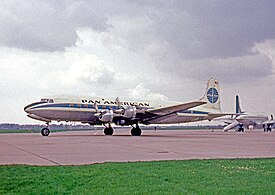 Pan Am Douglas DC-6B similar to the one destroyed at Shannon Airport | |
| Accident | |
|---|---|
| Date | June 22, 1959 |
| Summary | Propeller failure, engine separation |
| Site |
Shannon Airport,
Ireland 52°42′57.86″N 8°53′55.3″W / 52.7160722°N 8.898694°W |
| Aircraft | |
| Aircraft type | Douglas DC-6B |
| Aircraft name | Clipper Panama |
| Operator | Pan American World Airways |
| Registration | N5026K |
| Flight origin | Frankfurt |
| 1st stopover | Heathrow Airport |
| Last stopover | Shannon Airport |
| Destination | New York City |
| Passengers | 2 |
| Crew | 6 |
| Survivors | 8 |
Pan Am Flight Clipper Panama, Douglas DC-6B N5026K, was a cargo flight from Frankfurt to New York City. On 22 June 1959 it caught fire on takeoff and was destroyed. All six flight crew and two passengers survived.
Description
Pan American Airways Douglas DC-6B registered N5026K, named Clipper Panama [1] was delivered on 28 May 1954. In 1958 it spent some time on lease to National Airlines but was returned to Pan Am. [2]
On 22 June 1959, under charter, Clipper Panama departed Frankfurt for New York with intermediate stops at Heathrow Airport and Shannon Airport. Captain Robert Realm and First Officer Henry R. Hayes were onboard with a crew of four plus two passengers. [3] Having refueled at Shannon, the plane was preparing for take off and on applying takeoff power, a loud noise was heard and the takeoff abandoned. Engine No. 4 had separated from the wing and a fire erupted, destroying the aircraft just after the crew and passengers escaped in 30 seconds via the emergency chute. Six dogs died in the cargo hold, and an airport fire engine fighting the blaze caught fire and was destroyed. [4] [5]
According to the Dublin Evening Herald, cargo and some mail were destroyed in the resulting fire but it is unclear where the mail had been loaded. [3]
Cause of the accident
The No. 4 engine suffered a fatigue failure of its No. 1 propeller blade. According to lab results, the blade had previously been bent which resulted "in the disruption of the compressive stresses in the shot peened area of the propeller blade" being the probable cause because the unbalanced loads on the engine mounts resulted in the separation of the entire engine. [4]
References
- ^ "Names of Pan Am Clippers" (PDF). The Pan Am Historical Foundation. 2015. Retrieved 8 September 2017.
- ^ "Pan American Airways - Fleet List and Airframe Histories - The Douglas Prop Fleet". Databases. Logbook Magazine. 18 August 2015. Archived from the original on 1 June 2017. Retrieved 31 August 2017.
- ^ a b Vogt, Ronny (1997). Irish Crash Airmails. Bray: Irish Airmail Society. p. 218.
- ^ a b "Accident description". aviation-safety.net. 2017. Retrieved 31 August 2017.
- ^ UPI (23 June 1959). "Freight Plane Burns Awaiting Takeoff". The Panama American. Retrieved 31 August 2017.